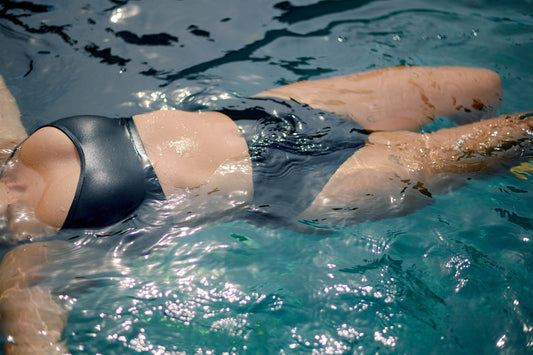
How to Use Your Menstrual Cycle to Your Advantage
Aisle TeamOur menstrual cycles can come with symptoms that affect our day-to-day lives, and not always in a positive way.
I tend to get pretty down on myself when I suddenly need ten hours of sleep instead of my usual eight. Or suddenly I need lots of protein at every meal, or require that extra boost of caffeine mid-day. There are also times when I feel less creative or less able to focus.
Do you find yourself asking questions like: why can’t I think clearly? Why am I suddenly so tired? Why can’t I crush it at the gym like I normally do?
If you do, I want you to know it’s totally normal. As period-havers, we move through our menstrual cycles with ups and downs of energy and productivity as our bodies adjust to continual hormonal shifts throughout our cycles.
Here’s how to navigate your menstrual cycle and all the phases that come with it.
The Phases of the Menstrual Cycle
Your Menstrual Cycle follows four distinct phases: menstruation, the follicular phase, ovulation, and the luteal phase .
These cycles occur over a typical range of 21 – 38 days. It’s important to note that your menstrual cycle won’t always be precise. But, if your menstrual cycle is shorter or longer than this general range, we suggest tracking on a handy app or in a journal to get a sense of your personal experience. If you think that your cycle may need some tending to, reach out to your medical provider or doctor to rule out any other reproductive health issues.
First up, menstruation.
Menstruation is typically known as the bleeding phase of your menstrual cycle. While the menstrual cycle occurs to prepare your body for pregnancy, when your body realizes it isn’t pregnant, your hormones send the DM to your uterus to shed its lining.
Your period blood is the lining of your uterus shedding and flowing out of your vagina. To manage the bleeding, common products used include pads, tampons, menstrual cups and the ever-amazing period underwear (our personal fave – though we are a bit biased!).
During menstruation, your estrogen and progesterone levels are at their lowest. Your body is working hard and shedding the lining of your uterine wall, using up extra stores of energy that deplete your blood and iron levels. This makes menstruation ideal for all things rest: taking a day in bed, warm baths, gentle walks and eating comfort food while watching your favourite show.
Following the menstrual phase, we have the follicular phase.
This phase actually starts the day you get your period and ends when you begin to ovulate – meaning it overlaps with your period. The follicular phase has two important functions: rising the level of estrogen in your body, along with FSH – the follicle-stimulating hormone.
Working together, the increase of estrogen and FSH tell your body it’s time to grow and increase the thickness of your uterine lining also known as your endometrium.
During the follicular phase, post-bleeding, you will likely start to feel your energy coming back. Maybe you won’t be ready to run a marathon, but this phase of your menstrual cycle is ideal for taking on larger physical tasks while still giving your body the space and rest it needs to recover from menstruating. Go ahead and enjoy some protein-food foods and get outside and go for that hike!
The ovulation phase is next and this is where things get fun.
A lot of period-havers experience a burst of energy when they are ovulating. Their entire perspective shifts, they feel sexy and alive! This is because the progesterone rises and your ovaries get your egg nice and ready, preparing for pregnancy. The egg is then released.
Feel free to get funky during this phase: write the book, paint the canvas, go dancing with your friends. You are unstoppable thanks to progesterone’s feel-good qualities. The ovulation phase is also the time to get back into your weight lifting, take on longer runs, and enjoy the physical workouts or hard sweats you love and enjoy.
The last leg of your menstrual cycle is the luteal phase (we made it!).
After ovulation, the follicle that was holding your egg in your ovary releases it. This phase overlaps with your ovulation phase but is more focused on preparing the lining of your uterus for pregnancy. Progesterone rises to help prepare your body for the potential egg-sperm meet-up, but if that doesn’t happen, your levels of estrogen and progesterone drop.
Then, we start the cycle all over again. What a ride!
The luteal phase is a mixed bag: while it overlaps with ovulation, it has its own distinct experience that prepares your body for your period. You may feel those bursts of energy for a few days where productivity and creativity are at their highest, then there is a slow change and move into the bleeding part of your menstrual cycle. Use this time to enjoy those bursts, and then begin to wind down by reading books, taking yoga and enjoying a bit of self-care.
Throughout your entire menstrual cycle, one thing should always be top priority: self-care. You and your body get to decide how it needs to be nourished at each phase of the cycle, and now that you know more about each phase, it will be easier to do things that feel GOOD.
And when your period does come, we have a few tips on how to have a comfortable period.
Amy Saunders is an SEO strategist and queer writer of poetry, prose, essays and branded content. Her work has been published in Chatelaine, VICE, TeenVogue, SheDoesTheCity and with brands such as DivaCup. She lives in the unceded and ancestral territory of Kjipuktuk with her husband and daughter.




